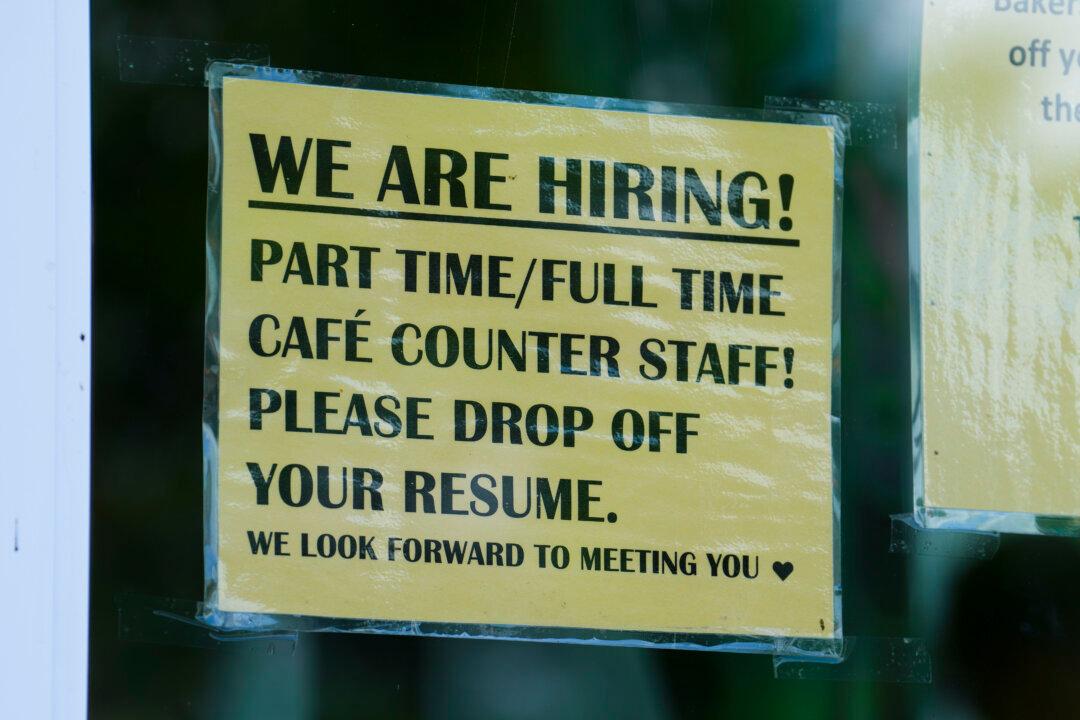Canada’s unemployment rate of 4.9 percent in July is a historic low, with over a million job vacancies, but underlying the headline statistics, small business has been struggling in the pandemic recovery as job growth migrates to government and larger firms.
Public sector employment is up 10.8 percent in the three years from July 2019 to July 2022, but private sector employment is only up 3.2 percent, according to Statistics Canada data. Self-employment is actually down 7.2 percent over those three years.
Also, employment in workplaces with over 500 employees is up 17.1 percent, whereas employment in workplaces with under 100 employees is up just 1.2 percent.
“It should be a concern for not just governments but all Canadians, because having a thriving, small, medium-sized business sector is what protects you from the multiplication of monopolies or oligopolies that are generally not so good for the consumers,” Simon Gaudreault, chief economist and VP of research at the Canadian Federation of Independent Business (CFIB), told The Epoch Times.
Gaudreault gives the theoretical example of how an economy is far more resilient if it has 10 100-employee firms rather than one 1,000-employee firm.
“It does create an economy that we can relate to, and that we can make sense of.”
He also stressed the anchor role of small business to communities all across the country.
Gaudreault also noted that when looking at total paid employment between July 2019 and July 2022, about half of it came from the public sector when normally just a quarter of it should come from the public sector.
Thus, small businesses are fighting a losing battle in the competition to survive, thrive, and attract employees in the pandemic recovery period.
“You [small businesses] have less access to an international support network. You have simply fewer employees. So it’s harder sometimes to find all of the resources that you need to pivot in critical moments like the past two years. You’ve had many businesses that have been shuttered,” Gaudreault said.
“They [small businesses] often don’t have the resources that the public sector has. For the public sector, you have the ability to give high-paying jobs with lots of benefits around that.”
And the government can always raise taxes to pay for its spending, Gaudreault reminds.
“It’s a very obvious trend that large employers did better during the pandemic,” Philip Cross, former chief economic analyst at Statistics Canada and Munk senior fellow at the Macdonald-Laurier Institute, told The Epoch Times.
He pointed to the financing options larger firms have at their disposal—issuing debt or stock, whereas small business is dependent on bank loans and government handouts.
Small Business Overlooked
“Our economy has recovered 112 percent of the jobs that were lost during those awful first months,” Finance Minister Chrystia Freeland said in the foreword to Budget 2022 in April. Three million Canadians had lost their jobs in the early days of the pandemic, she noted.
The Bank of Canada said in its July monetary policy report that the “labour market is tight along all dimensions.”
But the SME Profile: Ownership demographics statistics 2022 report published earlier in August by Innovation, Science and Economic Development (ISED) Canada paints a darker picture of the employment situation with small and medium-sized enterprises (SMEs).
A small business is defined as one that has between one and 99 employees, whereas a medium-sized business has between 100 and 499 employees.
The SME Profile report noted that about a third of all SMEs had temporary closures due to the pandemic.
As a broad example, both Gaudreault and Cross point to fewer workers returning to the downtown cores of major cities and less demand for the small service-oriented businesses that thrive on the office worker. Sectors like hospitality and tourism have been particularly affected by the pandemic and changing consumer spending patterns.





